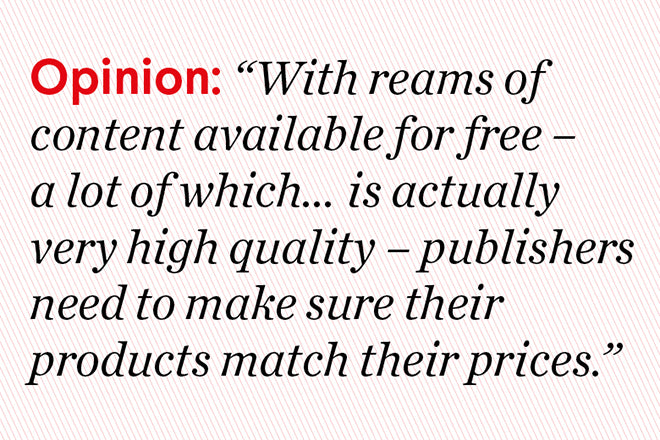
What is your content worth?
For his March column, Rob Alderson warns publishers not to over-estimate what readers will pay for their magazines
The recent announcement that the Independent newspaper is to stop producing a print product later this month was spun in two predictable ways – i) Forward-thinking media company has the guts to embrace a digital-only future and ii) Death knell of print as cowardly publisher cuts losses.
The think pieces appeared at a staggering rate and like the true media geek that I am – with my nerdy glasses and well-honed opinions on paywalls – I devoured them all. While some of the arguments and ideas were new (or at least repackaged, masquerading as new) the common thread that emerged was something publishers of all shapes and sizes have been struggling with for years: what are people prepared to pay for media?
Lisa Markwell, editor of the Independent on Sunday, gave an interview to the BBC’s Today programme, in which she bemoaned what she saw as the fucked up relationship between consumers and content.
“We have always found it terribly depressing that people will happily pay £3.70 for an appalling coffee from a takeout place and yet they won’t pay £1.60 or £2.20 on a Sunday for what is in effect a novel’s worth of terrific writing,” she said (as quoted in The Guardian).
There’s a two things wrong with this sentence. Firstly I don’t know where Lisa gets her coffee, but if I paid £3.70 for an “appalling” cup of coffee, I would be far from happy. Secondly – and I speak as a sometime buyer of the Indie – it’s a stretch to call the paper a “novel’s worth of terrific writing.” As proud and protective as she has every right to be, as an editor who who did impressive things with a small full-time staff of 12, this just isn’t accurate.
But her bigger point is spot on – that people are more reluctant to pay for information and entertainment than they once were.
As an avid podcast listener I am always interested that hosts like Richard Herring and Scroobius Pip feel the need to spend several minutes at the start of their programmes explaining media economics to their listeners. Scroobius Pip essentially articulates how sponsorship works at the start of every episode of Distraction Pieces; Richard Herring’s Leicester Square Theatre Podcast (RHLSTP) begins with the comedian running through various ways people can donate money to support the pod, and why that’s important.
Recently the mobile phone network Three announced that is was putting Adblocker software on all of its handsets as standard; an extraordinary gesture that reeks of a lack of respect for hard-working media platforms everywhere.
So with reams and reams of content available for free – a lot of which, contrary to received wisdom is actually very high quality – publishers need to make sure their products match their prices.
This is something magazine-makers need to consider. For a while now, the dominant narrative in our world has been that while traditional print products struggle, independent magazines with niche subject matter and high production values have flourished. So while the newspaper, with its huge cost base, shifting sense of identity and diminishing relevance tanks, it’s all sweetness and light for your oh-so-cool, kickstarted, tactile, minimalist magazine (as Gym Class Magazine might put it).
But as much as this version of events succours and emboldens us, I am concerned it may also lull us into a false sense of security. No magazine maker should feel overly confident about this relationship between what things are worth and what people are prepared to pay. Browsing the shelves of indie magazine specialists, I am often bemused by the prices of many titles.
I will regularly flick through a publication only to regretfully place it back on the shelf when I see how much it costs. Similarly during my time at It’s Nice That, we would often have to remind ourselves to consider value for money when reviewing magazines, seeing as we were sent most things for free and the temptation was to assess titles from just the design and editorial points of view.
It’s important to point out that in discussing this post with Jeremy Leslie, he told me that his experience in the magCulture shop was that very few buyers appear to be deterred by how much a magazine costs, which is great.
But even this feeds into this idea of the golden age of indie publishing, which we mustn’t take for granted. It’s vital that magazine makers think carefully about what they’re charging, that they take into account their own business models, the cost of equivalent titles competing for the same readers, and broader cultural shifts in people’s relationship to paid-for content.
And it’s worth remembering there was a time, not that long ago, when newspapers felt untouchable too.


